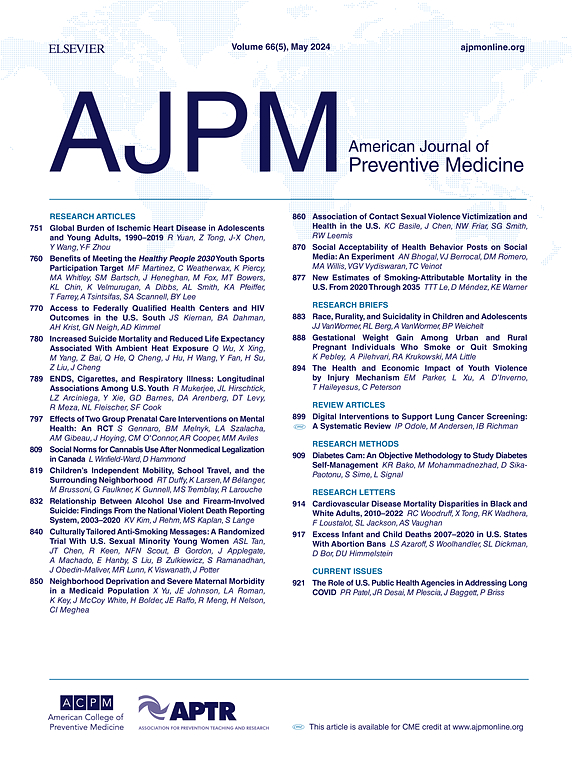Military Veterans’ Psychological Health and Physical Activity After Separation From Service
IF 4.3
2区 医学
Q1 MEDICINE, GENERAL & INTERNAL
引用次数: 0
Abstract
Introduction
The transition from military to civilian life can bring about substantive challenges for U.S. veterans. The purpose of this study was to examine veterans’ trajectories of psychological health prior to and after separation, and to examine whether veterans who engaged in more physical activity would report better psychological health over time.
Methods
Longitudinal data between 2001 and 2016 from the Millennium Cohort Study were analyzed, which consisted of U.S. military personnel who separated from service, followed up every 3–5 years. Veterans (N=37,464, Mage=36.3 years, SD=10.9 at baseline) who had self-report data collected prior to and on at least 2 time points after separation were analyzed. Psychological health was operationalized via measures of self-reported mental health-related quality of life, depressive symptoms, and post-traumatic stress disorder symptoms. Physical activity was measured using self-reported minutes per week of moderate-to-vigorous physical activity. Parallel process latent growth modeling was used to examine the relationship between physical activity and psychological health.
Results
Results revealed decreases in psychological health after separation. Veterans with higher pre-separation physical activity were more likely to display steeper trajectories of decreased physical activity and psychological health after separation. In contrast, veterans who engaged in higher levels of physical activity after separation displayed increases in psychological health after separation.
Conclusions
Findings suggest that high levels of physical activity during service may not protect against worsened psychological health trajectories after separation. However, the results provide support for the potential protective factor of physical activity after separation on psychological health symptoms after separation.
退伍军人离职后的心理健康和身体活动
导读:从军事生活到平民生活的过渡可能给美国退伍军人带来实质性的挑战。本研究的目的是研究退伍军人在分离前后的心理健康轨迹,并研究从事更多体育活动的退伍军人是否会随着时间的推移报告更好的心理健康状况。方法:对2001-2016年千禧年队列研究的纵向数据进行分析,该数据由美国退役军人组成,每3-5年随访一次。退伍军人(N = 37,464,法师 = 36.3,SD = 10.9)在分离前和分离后至少两个时间点收集了自我报告数据。心理健康以自我报告的心理健康相关生活质量、抑郁症状和创伤后应激障碍症状来衡量。身体活动是通过每周自我报告的中等到剧烈身体活动的分钟数来测量的。平行过程潜在增长模型被用来检验身体活动和心理健康之间的关系。结果:结果显示分离后心理健康状况下降。退伍军人在分离前有较高的体力活动,在分离后更有可能表现出更陡峭的体力活动减少和心理健康的轨迹。相比之下,那些在分离后从事高水平体育活动的退伍军人在分离后的心理健康状况有所改善。结论:研究结果表明,服役期间高水平的身体活动可能不能防止分离后心理健康轨迹的恶化。然而,研究结果为分离后体育活动对分离后心理健康症状的潜在保护因素提供了支持。
本文章由计算机程序翻译,如有差异,请以英文原文为准。
求助全文
约1分钟内获得全文
求助全文
来源期刊

American Journal of Preventive Medicine
医学-公共卫生、环境卫生与职业卫生
CiteScore
8.60
自引率
1.80%
发文量
395
审稿时长
32 days
期刊介绍:
The American Journal of Preventive Medicine is the official journal of the American College of Preventive Medicine and the Association for Prevention Teaching and Research. It publishes articles in the areas of prevention research, teaching, practice and policy. Original research is published on interventions aimed at the prevention of chronic and acute disease and the promotion of individual and community health.
Of particular emphasis are papers that address the primary and secondary prevention of important clinical, behavioral and public health issues such as injury and violence, infectious disease, women''s health, smoking, sedentary behaviors and physical activity, nutrition, diabetes, obesity, and substance use disorders. Papers also address educational initiatives aimed at improving the ability of health professionals to provide effective clinical prevention and public health services. Papers on health services research pertinent to prevention and public health are also published. The journal also publishes official policy statements from the two co-sponsoring organizations, review articles, media reviews, and editorials. Finally, the journal periodically publishes supplements and special theme issues devoted to areas of current interest to the prevention community.
 求助内容:
求助内容: 应助结果提醒方式:
应助结果提醒方式:


